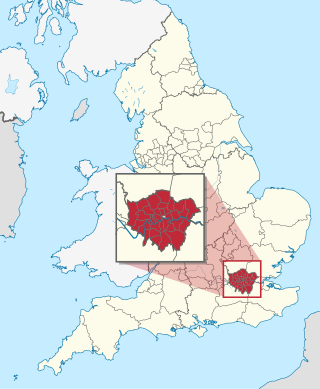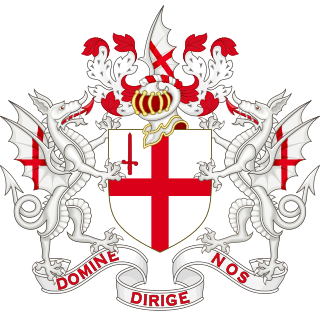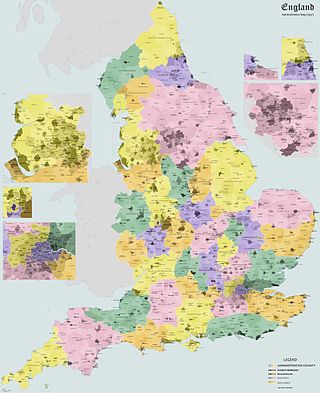Related Research Articles

The Greater London Authority (GLA), colloquially known by the metonym "City Hall", is the devolved regional governance body of Greater London, England. It consists of two political branches: the executive Mayoralty and the 25-member London Assembly, which serves as a means of checks and balances on the former. Since May 2016, both branches have been under the control of the London Labour Party. The authority was established in 2000, following a local referendum, and derives most of its powers from the Greater London Authority Act 1999 and the Greater London Authority Act 2007.

The London boroughs are the 32 local authority districts that together with the City of London make up the administrative area of Greater London, England; each is governed by a London borough council. The present London boroughs were all created at the same time as Greater London on 1 April 1965 by the London Government Act 1963 and are a type of local government district. Twelve were designated as Inner London boroughs and twenty as Outer London boroughs. The City of London, the historic centre, is a separate ceremonial county and sui generis local government district that functions quite differently from a London borough. However, the two counties together comprise the administrative area of Greater London as well as the London Region, all of which is also governed by the Greater London Authority.

The Greater London Council (GLC) was the top-tier local government administrative body for Greater London from 1965 to 1986. It replaced the earlier London County Council (LCC) which had covered a much smaller area. The GLC was dissolved in 1986 by the Local Government Act 1985 and its powers were devolved to the London boroughs and other entities. A new administrative body, known as the Greater London Authority (GLA), was established in 2000.
An alderman is a member of a municipal assembly or council in many jurisdictions founded upon English law. The term may be titular, denoting a high-ranking member of a borough or county council, a council member chosen by the elected members themselves rather than by popular vote, or a council member elected by voters.

The London County Council (LCC) was the principal local government body for the County of London throughout its existence from 1889 to 1965, and the first London-wide general municipal authority to be directly elected. It covered the area today known as Inner London and was replaced by the Greater London Council. The LCC was the largest, most significant and most ambitious English municipal authority of its day.

The City of London Corporation, officially and legally the Mayor and Commonalty and Citizens of the City of London, is the municipal governing body of the City of London, the historic centre of London and the location of much of the United Kingdom's financial sector.
A county council is the elected administrative body governing an area known as a county. This term has slightly different meanings in different countries.

Municipal boroughs were a type of local government district which existed in England and Wales between 1835 and 1974, in Northern Ireland from 1840 to 1973 and in the Republic of Ireland from 1840 to 2002. Broadly similar structures existed in Scotland from 1833 to 1975 with the reform of royal burghs and creation of police burghs.

Finchley, which is now in north London, was a local government district in Middlesex, England, from 1878 to 1965. Finchley Local Board first met in 1878. It became Finchley Urban District Council in 1895 and the Municipal Borough of Finchley in 1933. In 1965 Middlesex was abolished and Finchley became part of the London Borough of Barnet.

Leicester City Council is a unitary authority responsible for local government in the city of Leicester, England. It consists of 54 councillors, representing 22 wards in the city, overseen by a directly elected mayor. It is currently controlled by the Labour Party and has been led by Mayor Sir Peter Soulsby since his election on 6 May 2011. The main council offices are at City Hall on Charles Street, but council meetings are held in the 19th-century Town Hall.

The Local Government Act 1888 was an Act of Parliament which established county councils and county borough councils in England and Wales. It came into effect on 1 April 1889, except for the County of London, which came into existence on 21 March at the request of the London County Council.

The Local Government Act 1894 was an Act of the Parliament of the United Kingdom that reformed local government in England and Wales outside the County of London. The Act followed the reforms carried out at county level under the Local Government Act 1888. The 1894 legislation introduced elected councils at district and parish level.
A municipal council is the legislative body of a municipality or local government area. Depending on the location and classification of the municipality it may be known as a city council, town council, town board, community council, rural council, village council, or board of aldermen.

The London Government Act 1899 was an Act of the Parliament of the United Kingdom that reformed the administration of the capital. The Act divided the County of London into 28 metropolitan boroughs, replacing the 41 parish vestries and District Boards of Works administering the area. The legislation also transferred a few powers from the London County Council to the boroughs, and removed a number of boundary anomalies. The first elections to the new boroughs were held on 1 November 1900.

The Local Government Act 1933 was an Act of the Parliament of the United Kingdom that consolidated and revised existing legislation that regulated local government in England and Wales. It remained the principal legislation regulating local government until the Local Government Act 1972 took effect in 1974.

The County Borough of Leeds, and its predecessor, the Municipal Borough of Leeds, was a local government district in the West Riding of Yorkshire, England, from 1835 to 1974. Its origin was the ancient borough of Leeds, which was reformed by the Municipal Corporations Act 1835. In 1889, when West Riding County Council was formed, Leeds became a county borough outside the administrative county of the West Riding; and in 1893 the borough gained city status. The borough was extended a number of times, expanding from 21,593 acres (8,738 ha) in 1911 to 40,612 acres (16,435 ha) in 1961; adding in stages the former area of Roundhay, Seacroft, Shadwell and Middleton parishes and gaining other parts of adjacent districts. In 1971 Leeds was the fifth largest county borough by population in England. The county borough was abolished in 1974 and replaced with the larger City of Leeds, a metropolitan district of West Yorkshire.
The history of local government in England is one of gradual change and evolution since the Middle Ages. England has never possessed a formal written constitution, with the result that modern administration is based on precedent, and is derived from administrative powers granted to older systems, such as that of the shires.
The Royal Commission on the Corporation of the City of London was a Royal Commission, established in 1853, which considered the local government arrangements of the City of London and the surrounding metropolitan area.

Medway Council is the local authority of Medway in Kent, England. It is a unitary authority, having the powers of a non-metropolitan county and district council combined.

Plymouth City Council is the local authority for Plymouth, a unitary authority with city status in the ceremonial county of Devon, England.
References
- 1 2 3 Young, K. & Garside, P., Metropolitan London: Politics and Urban Change, (1982)
- ↑ "Mr Asquith on London Government". The Times . 8 December 1894. p. 7.
- 1 2 "London County Council". The Times. 6 November 1895. p. 8.
- 1 2 3 4 5 6 7 8 9 10 11 12 13 14 15 16 17 18 19 20 21 "London Amalgamation - The Commissioners' Report". The Times. 1 October 1894. pp. 13–14.
- ↑ "Lord Rosebery and the London County Council". The Times. 6 February 1892. p. 7.
- ↑ "The London County Council Election". The Times. 7 March 1892. p. 10.
- ↑ "Proposed Reform of London Taxation". The Times. 24 November 1892. p. 12.
- ↑ "Political Notes". The Times. 23 February 1893. p. 10.
- ↑ "Political Notes". The Times. 24 February 1893. p. 10.
- ↑ "The London County Council". The Times. 8 March 1893. p. 12.
- 1 2 3 4 "No. 26391". The London Gazette . 11 April 1893. pp. 2167–2168.
- ↑ "Correspondence and Papers of Robert Durning Holt". Online Catalogue. Liverpool Record Office. Retrieved 4 August 2009.
- ↑ Beckett, J V (2005). City status in the British Isles 1830 – 2002. Aldershot: Ashgate Publishing Limited. p. 49. ISBN 0-7546-5067-7.
- ↑ "The Corporation and the Unification of London". The Times. 17 November 1893. p. 12.
- ↑ "Sir C. Russell on the Unification of London". The Times. 1 December 1893. p. 13.
- ↑ "The Unification of London". The Times. 19 December 1893. p. 5.
- ↑ "The Unification of London". The Times. 16 February 1894. p. 9.
- ↑ The Times. 16 February 1894.
{{cite news}}: Missing or empty|title=(help) - ↑ "The County Council and the Amalgamation Commission". The Times. 27 February 1894. p. 4.
- ↑ "The Government of London". The Times. 16 October 1894. p. 4.
- ↑ "Lord Salisbury On London Government". The Times. 8 November 1894. p. 4.
- ↑ "The Unification of London". The Times. 5 November 1894. p. 6.
- ↑ "The Corporation & The Unification Commission". The Times. 5 October 1894. p. 5.
- 1 2 "The City & The Unification Scheme". The Times. 8 January 1895. p. 6.
- ↑ "Mr Asquith On London Government". The Times. 8 December 1894. p. 7.
- ↑ "Lord Rosebery On London Government". The Times. 15 June 1895. p. 16.
- ↑ "Conference of the National Union of Conservative and Constitutional Associations". The Times. 17 November 1897. p. 8.
- ↑ "London Government Bill". The Times. 2 March 1899. p. 10.
- ↑ "The London Government Bill". The Times. 18 March 1899. p. 5.